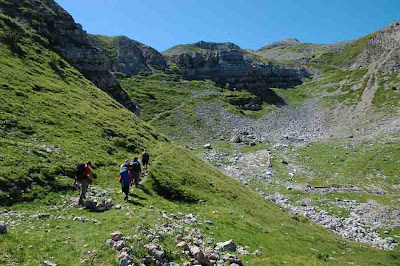On top of each peak is a crumbling reminder of a presence of a fighting force, be they bunkers or lookout points. They are sad reminders of the tactics that were used on these peaks: the Austrians were strict adherents of fighting for the highest ground in any terrain. It's a classic and previously unchallenged tactic, since a higher ground allows one to see and shoot at the enemy below. But just like this war put into question many techniques previously thought of as fool proof, so it did to this idea. While thousands of Austrians and Italians were dying trying to capture the tallest peaks, many others were busy digging under them trying to blow up these peaks from below. The race to the highest points and the battle of Pasubio ended when the Austrians finally succeded in blowinng up the Italian side--called the Dente Italiano--in March 13, 1918. The 55 casualties seem like nothing compared to the thousands that previously died, but the landscape was completely altered, with the top of one of the highest peaks in Pasubio completely blown off. The devastation was so extensive that vegetation still has not come back after almost a hundred years.
Above, Rifugio Lancia sits on the opposite side of Cima Palon, the tallest peak in Pasubio, about a few hours walk. Nowadays, the mountain is relatively buccolic, especially in the more remote parts away from Rifugio Papa. No matter how peaceful however, the smallest things can jolt one out of the serenity. In the valley pictured below, there is an Austrian bunker around the next turn, intentionally hidden from Italian bombers and artilery hits. The area around is littered with remnants of boots, tinned rations, and human bones.
The area around Rifugio Papa (pictured below) is crowded, but for a good reason. The rifugio itself is heartbreakingly picturesque, and stands as a testament to the hardiness of the people in these parts. Hugging the steep sides of the mountain, one wonders how such a building could be built in 1929, with only the help of vehicles powerful enough to travel up the worn paths of the first world war. Behind the refugio, on the other side of the cliff is a malga, a farm high up in the mountain occupied during the summer when pastures are more plentiful than in the plains below. When the farm is open it is possible to buy sheep's milk, cheese, or just a plate of sopressa and polenta.
Finally, from Rifugio Papa the entrance to the Strada de 52 Gallerie is only a hundred or so meters away. The road was used by the Italian army to deliver provisions to the units on top of the mountain, but the keen observer would have been baffled since on the other side of the mountain lies a perfectly driveable road, the Scarubbi, that goes all the way up to the area where Rifugio Papa is located. However, when the Austrians took control of the peak directly across the Scarubbi, it became far too dangerous to use that road due to its high level of exposure to artillery attacks. Although the painful solution to the dilemma is the tortured road that goes through 52 caves before reach the top, the road is nevertheless a vast engineering feat, complete in only nine months despite difficult terrain, limited number of workers, and provisions to which the road has second priority after the war itself. The most amazing part of the trail is gallery #20, which is a long path that corkscrews inside the mountain to drop (or rise, depending on which direction you are going) a couple of hundreds of meters below. The road provides great panoramic views of Valli del Pasubio and the Vicentino plains beyond, but the the steep cliffs and narrow paths really give one appreciation for the difficulties Soldiers must have had to face in simply crossing this road to deliver provisions above.
At the entrance of the Strada de 52 Gallerie, one has the option of driving down to Posina, a little village at the bottom Val Posina, accessed through Passo Xomo. It's a beautiful area, and worth visiting just for the sake of doing so. But the best part of visiting the village of Posina is eating in either Trattoria all'Alpini or or Trattoria Garibaldini, two competing restaurants that specialize in gnocchi. The rivalry between the restaurants is storied and legendary, and for my money the gnocchi in Trattoria Garibaldini--the only one I have tried, as of yet--were too pillowy and delicious to even imagine being bettered.









Fantastic details and description of this hike. This is on our "must-do" list, so it was a real treat to see your photos!
ReplyDeleteGlad you enjoyed it! Pasubio is really a great place to visit, and better still if one goes beyond the 52 Galleries to the top of Cima Palon,a harder hike but definitely worth it.
ReplyDelete